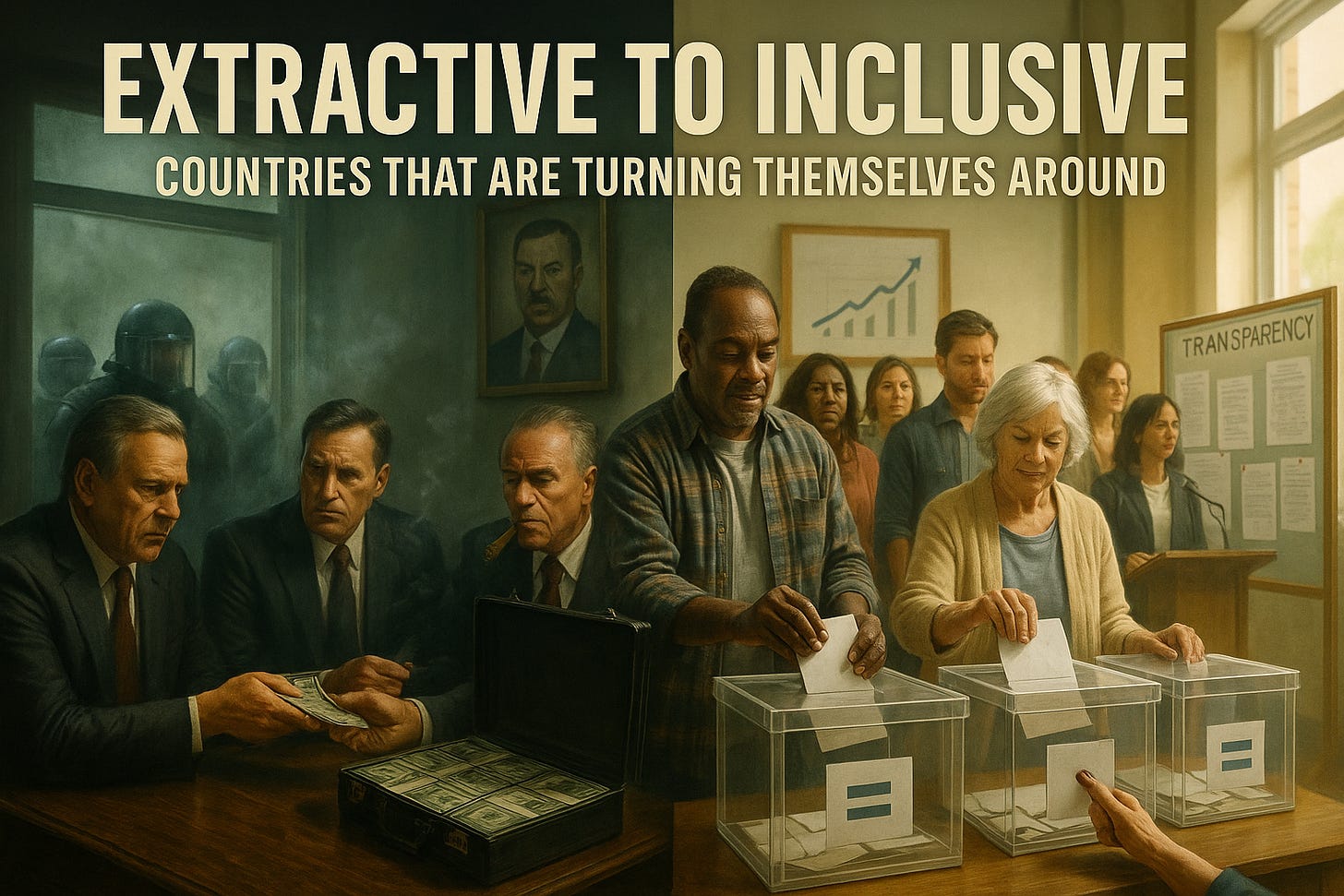Extractive To Inclusive - Countries That Are Turning Themselves Around
The U.S. is unraveling. Russia threatens Europe. Yet, many nations are getting better
Some countries are quietly getting better at serving ordinary people. These are nations creating governments and economies for the people. They’re making rules fairer, opening opportunities to more citizens, and delivering services that work. Today, we’ll explain what makes a system “inclusive” rather than “extractive,” and over the week, profile four countries that show real turnarounds. The Prime Brief will finish by looking at what they have in common, where they differ, and if a tweak in culture and the right archetype leaders can put a country on the right track.
What are “inclusive” and “extractive” systems?
Think of a country’s institutions as the rules of the game, laws, norms, and habits that shape how government, business, and everyday life actually work. Economists call institutions the “constraints” that structure human interaction.
When rules are predictable, fair, and cover as many people as possible, people invest, innovate, and plan. This is when economies grow, everyone shares in the wealth, nations become strong, and the happiness index surges. When they are arbitrary, people hold back because of the uncertainty. This is when the economy and nation weaken and spiral downward. (Cambridge University Press & Assessment)
Inclusive institutions spread opportunity broadly. They protect property rights, apply the law evenly, allow new firms to compete on a level playing field, and encourage and protect new ideas and ways of doing things. The benefits of economic growth include as much of the population as possible.
Extractive institutions tilt rules toward a narrow group of elites, blocking competition. Opportunity is limited for most people, and new ideas and change are discouraged and penalized. Laws are applied harshly to the poor and minorities and lightly, if at all, to those in power. Those in power extract the wealth from the economy for themselves.
This inclusive–extractive lens is strongly associated with the work of Daron Acemoglu and James A. Robinson, recognized for research showing how inclusive institutions support long-run prosperity while extractive ones stunt it. (Wall Street Journal)
How inclusive and extractive are measured
We’ll stick to transparent, reputable sources and simple questions:
Are basic legal rules in place, applied equally, and working?
The World Justice Project’s Rule of Law Index combines surveys of households and experts to gauge real-life experiences with courts, corruption, police, and rights. We’ll look at level and trend; are checks on power strengthening, and are people seeing improvement year to year? Better rule-of-law scores that reflect daily experience, not just laws on paper. (World Justice Project)Are the gains reaching ordinary people?
GDP alone isn’t enough. We will track “shared prosperity”, the income growth of the bottom 40% of the population, and poverty rates (national and international lines). If the bottom 40% is moving up, that’s a practical sign of inclusion. (World Bank).Are policies consistent with inclusion?
We’ll check whether governments are investing in people and lagging regions, improving competition and job access, and effectively delivering services, benchmarks aligned with the OECD’s framework for “inclusive growth.” (OECD)
While there is much more to determining inclusive versus extractive, these are three strong indicators. We will look at how they move together.
We’ll also add a cultural lens and Hornby’s archetypes to explain how change is happening:
Cultural dimensions (Hofstede, Trompenaars, Hall, Schwartz, GLOBE) help us see why some reforms are easier or harder in different settings, for example, a strong preference for rule-by-law versus favoritism, or low-context versus high-context communication. We’ll reference these only where they clarify policy choices and public expectations.
Hornby’s archetypes will describe leadership and societal style in the turnaround: North (Power-seeker), South (Worker), West (Sage), East (Communicator), Blue (Guardian), Red (Mother), Yellow (Creative), Green (Caregiver), and, where appropriate, the two integrative types Mediator (idea-based self-awareness) and Counsellor (feeling-based self-awareness). For example, a Blue/Guardian tilt may show up in rebuilding courts and other public-goods protections; a West/Sage tilt in evidence-driven policy design; an East/Communicator tilt in consensus-building and public buy-in; and a Green/Caregiver tilt in expanding social protection and access to services.
The Prime Brief
After the four profiles, we’ll compare them side-by-side: Which cultural dimensions recur in successful turnarounds? Which Hornby archetypes show up most often? What practical elements could other countries adapt? The goal is to identify common, transferable building blocks of inclusion, rules that work, opportunities that spread, and services that people can trust.
More on TikTok and Youtube



